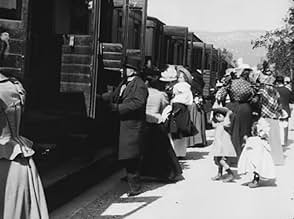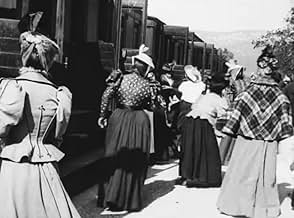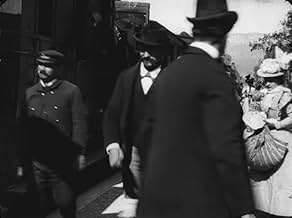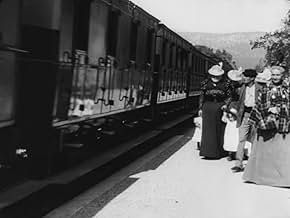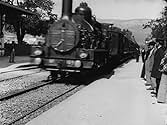A train arrives at La Ciotat station.A train arrives at La Ciotat station.A train arrives at La Ciotat station.
Featured reviews
At just under a minute, L'Arrivée d'un train à La Ciotat (1895) is one of Louis Lumiere's earliest excursions into film-making. As was formulaic with what he called "actualités," or non-narrative shorts, Louis Lumiere set up his cinematographe (a portable crank-handled camera that triples as a film projector and developer) at such an accomplished angle as to catch the arrival of a train at La Ciotat, where it captures the bustling comers-and-goers of the station who happen to stray in front of the lens, looking altogether curious, or else wary of the unfamiliar contraption. The crowd seems lively enough, but just for good measure, Lumiere's refined wife and mother-in-law can be seen actively searching for an imaginary, but eagerly expected passenger.
As uninteresting as it is (and it IS, even for the most pretentious film buff), L'Arrivée d'un train à La Ciotat's historical appeal is undeniable, if not legendary. The film's effect upon its first public viewing is a well-worn myth told to enthusiastic film students by their professors. Apparently, initial audiences, unaware of film's capacity to fully imitate reality, fled in fear of the image of a train barreling down upon the screen. The French newspaper, Le courrier du centre, (July 14, 1896) alleged the advancing locomotive made "spectators draw back instinctively fearing they'd be run over by the steel monster." Nevertheless, such a widespread and instantaneous physical response seems foolish or naïve even then, especially when the projector would have been visible and the sound audible to all seated in what at that time passed as a "theater." In reality, it is far more likely that this incident was limited to a few isolated cases, and was later exaggerated to enhance its appeal and boost the film's reputation. Consequently, the commerciality of the venture succeeded with tremendous results. Over a hundred years later, not only is L'Arrivée d'un train à La Ciotat a cinematic icon, but proof of how powerful and impressionable moving pictures could (and would) become.
Recommended for those with an interest in film as an art form, or for those looking for early examples of film in history.
As uninteresting as it is (and it IS, even for the most pretentious film buff), L'Arrivée d'un train à La Ciotat's historical appeal is undeniable, if not legendary. The film's effect upon its first public viewing is a well-worn myth told to enthusiastic film students by their professors. Apparently, initial audiences, unaware of film's capacity to fully imitate reality, fled in fear of the image of a train barreling down upon the screen. The French newspaper, Le courrier du centre, (July 14, 1896) alleged the advancing locomotive made "spectators draw back instinctively fearing they'd be run over by the steel monster." Nevertheless, such a widespread and instantaneous physical response seems foolish or naïve even then, especially when the projector would have been visible and the sound audible to all seated in what at that time passed as a "theater." In reality, it is far more likely that this incident was limited to a few isolated cases, and was later exaggerated to enhance its appeal and boost the film's reputation. Consequently, the commerciality of the venture succeeded with tremendous results. Over a hundred years later, not only is L'Arrivée d'un train à La Ciotat a cinematic icon, but proof of how powerful and impressionable moving pictures could (and would) become.
Recommended for those with an interest in film as an art form, or for those looking for early examples of film in history.
A train arrives at a station. And changes everything.
There isn't a lot to really say about L'arrivée d'un train a La Ciotat as a film itself. It's under a minute and shows a train pull up at a busy station. But what it signifies is another thing altogether. When we see that train come closer and closer until it stops in the station, on a surface level we watch a train arrive but it actuality what we are really witnessing is cinema arrive. This short film may not be the earliest movie but it is the first iconic image of the moving picture age.
Auguste and Louis Lumière weren't really artists. Their early films don't stand up to the highly imaginative work of George Méliès for example. But they still remain enormously important cinema giants. Not for the content of their films but for the fact that they kicked things off in the first place and produced the first iconic moment in cinema history. And for this reason L'arrivée d'un train a La Ciotat will always be remembered. Everyone who has a love of cinema should really take a minute of their time to pay homage to the first moment in an amazing journey.
There isn't a lot to really say about L'arrivée d'un train a La Ciotat as a film itself. It's under a minute and shows a train pull up at a busy station. But what it signifies is another thing altogether. When we see that train come closer and closer until it stops in the station, on a surface level we watch a train arrive but it actuality what we are really witnessing is cinema arrive. This short film may not be the earliest movie but it is the first iconic image of the moving picture age.
Auguste and Louis Lumière weren't really artists. Their early films don't stand up to the highly imaginative work of George Méliès for example. But they still remain enormously important cinema giants. Not for the content of their films but for the fact that they kicked things off in the first place and produced the first iconic moment in cinema history. And for this reason L'arrivée d'un train a La Ciotat will always be remembered. Everyone who has a love of cinema should really take a minute of their time to pay homage to the first moment in an amazing journey.
Like the notorious inflation adjustment that gives Gone With the Wind (1939) the unbreakable box-office high, a slight technological adjustment given the time (109 years ago!) gives Arrival of a Train at La Ciotat (1895) the best special effects ever (relatively speaking, of course). Forget King Kong (1933), throw out Star Wars (1977), Arrival of a Train' blew audiences away with a little thing called moving pictures. There's a classic rumor of audiences running away from the movie screen, expecting the train to crash right through! As scary as Kong was, nobody expected him to reach into the audience and pick out a few snacks!
Also, it may not have been all that intentional, but the composition of this static, one-minute shot is excellent, and still unrivaled. The perspective of the train zooming past the lens like a wild stampede, the quick stop, then, the explosion of activity: people coming, going, on the train, off the train. What crisp energy! What a film! Viva la Lumiere!
Also, it may not have been all that intentional, but the composition of this static, one-minute shot is excellent, and still unrivaled. The perspective of the train zooming past the lens like a wild stampede, the quick stop, then, the explosion of activity: people coming, going, on the train, off the train. What crisp energy! What a film! Viva la Lumiere!
10jhaugh
Having invented a hand-cranked, motion-picture camera during the year 1894 - and making films that could be exhibited to scientific groups during the early months of 1895; Louis Lumiere was a driven man. During one exhibition of the Cinematograph at the Societe d'Encouragement pour l'Industrie Nationale, he met an engineer (Jules Carpentier) who wished to manufacture the invention for selling in Paris. Louis accepted the proposal. Initial production would be 25 units. They would be professionally manufactured as opposed to the inventors experimental camera. Louis continued to use this camera to gather enough views for a public presentation at the end of the year.
There were a number of problems in producing the first prototype of the twenty-five units. Even when Louis, exhausted, took some rest-and-relaxation at the Lumiere's vacation house in the town of le Ciotat (pronounced see-oh-tah), he could not relax; and remained in constant communication with Jules in Paris. Louis was able to communicate on a daily basis with Jules because the mail trains of "le P.L.M. (Paris-Lyon-Mediterranee)" railway provided him with a means of staying in touch as well as providing his transportation between Lyon and la Ciotat.
Still driven by his work, he decided to go to the station and use the arriving train as one of his subjects. Perhaps wanting to assure that there would be plenty of action to record on the station platform, he took along his mother, his wife, and his two children along with their nanny. They all ventured forth, on a bright sunshiny Mediteranean day - la Ciotat is on the southern coast of France, between Marseille and Toulon, where people came to sunbathe and fish - the group ventured forth to the train station on the northern edge of the town with the verdant foothills of the Alpes de Provence providing a backdrop to the railroad.
Louis' wife, in a neck-to-foot elegant dress with a pristine white bonnet, and the nanny were instructed to run around the platform and appear as if they were trying to locate an expected-arriver as the train ground to a halt. The mother, in a shawl, would quietly observe - as a good matriarch should. Louis could not position his camera and let the train chug from right to left across the view because he would just capture a blur. He positioned it very near the track so the train would be seen in its entire length; and then rattle by very close to the viewer. The station personnel, in uniform, would hold back the crowd of departing people on the platform until the train had halted.
So the train arrives; locomotive and tender pass to the left of the camera followed by a mail car and a string of passenger cars. Louis has been cranking since the train was in good view. The crowd on platform can be restrained no more. They break ranks and move to the platform edge, ready to board, as the train stops. The two women with children in hand bustle about looking for someone. The matriarch stands still - observing. A young, and unscripted, peasant lad wanders about seemingly unsure as to where he should go to find his car. Dazed by the adventure of his first train ride? Then the doors open (on the French railway equipment the compartments are entered/exited directly to the platform.) Passengers begin to detrain. Louis has run out of film and stops cranking.
The first railroad train to star in a movie prepares to move on to Toulon (on schedule no doubt.)
There were a number of problems in producing the first prototype of the twenty-five units. Even when Louis, exhausted, took some rest-and-relaxation at the Lumiere's vacation house in the town of le Ciotat (pronounced see-oh-tah), he could not relax; and remained in constant communication with Jules in Paris. Louis was able to communicate on a daily basis with Jules because the mail trains of "le P.L.M. (Paris-Lyon-Mediterranee)" railway provided him with a means of staying in touch as well as providing his transportation between Lyon and la Ciotat.
Still driven by his work, he decided to go to the station and use the arriving train as one of his subjects. Perhaps wanting to assure that there would be plenty of action to record on the station platform, he took along his mother, his wife, and his two children along with their nanny. They all ventured forth, on a bright sunshiny Mediteranean day - la Ciotat is on the southern coast of France, between Marseille and Toulon, where people came to sunbathe and fish - the group ventured forth to the train station on the northern edge of the town with the verdant foothills of the Alpes de Provence providing a backdrop to the railroad.
Louis' wife, in a neck-to-foot elegant dress with a pristine white bonnet, and the nanny were instructed to run around the platform and appear as if they were trying to locate an expected-arriver as the train ground to a halt. The mother, in a shawl, would quietly observe - as a good matriarch should. Louis could not position his camera and let the train chug from right to left across the view because he would just capture a blur. He positioned it very near the track so the train would be seen in its entire length; and then rattle by very close to the viewer. The station personnel, in uniform, would hold back the crowd of departing people on the platform until the train had halted.
So the train arrives; locomotive and tender pass to the left of the camera followed by a mail car and a string of passenger cars. Louis has been cranking since the train was in good view. The crowd on platform can be restrained no more. They break ranks and move to the platform edge, ready to board, as the train stops. The two women with children in hand bustle about looking for someone. The matriarch stands still - observing. A young, and unscripted, peasant lad wanders about seemingly unsure as to where he should go to find his car. Dazed by the adventure of his first train ride? Then the doors open (on the French railway equipment the compartments are entered/exited directly to the platform.) Passengers begin to detrain. Louis has run out of film and stops cranking.
The first railroad train to star in a movie prepares to move on to Toulon (on schedule no doubt.)
There doesn't seem to be anything particularly exciting about an approaching steam locomotive, but somehow this image has stuck, the first iconic scene in cinematic history. Produced by pioneering French filmmakers Auguste and Louis Lumière, 'L' Arrivée d'un train à La Ciotat / Arrival of a Train at La Ciotat' was filmed at La Ciotat, Bouches-du-Rhône, France on December 28, 1895 and first screened to a paying audience on January 6, 1896. The 50-second long film, like most other Lumière shorts, successfully captures a brief snippet of everyday life, chronicling the gradual approach of the train, its slow to a halt, and the disembarkment of its passengers.
For many years, there has been an enduring myth than, upon the first screening of the film, the audience was so overwhelmed by the image of the train bearing down upon them that they fled the room in terror. This has been shown to be something of an embellishment, and, though the film would undoubtedly have astounded and mesmerised audiences, there was never any real mass panic. French scientist Henri de Parville, who attended an early screening, is said to have written: "The animated photographs are small marvels. ...All is incredibly real. What a power of illusion! ...The streetcars, the carriages are moving towards the audience. A carriage was galloping in our direction. One of my neighbors was so much captivated that she sprung to her feet... and waited until the car disappeared before she sat down again." This, I think, adequately sums up how remarkable the film must have seemed back in 1896.
Auguste and Louis Lumière obviously recognised the power of illusion offered by their Cinématographe. In order to maximise the shock value of the approaching train, they have mounted the camera as close as possible to the edge of the platform, so that the audience feels as if they are almost standing right in the locomotive's path. The people departing from the train are just normal citizens going about their day (several Lumière relatives, however, can be spied on the platform), enhancing the realism of the short. Cinema does not get much more memorable than this.
For many years, there has been an enduring myth than, upon the first screening of the film, the audience was so overwhelmed by the image of the train bearing down upon them that they fled the room in terror. This has been shown to be something of an embellishment, and, though the film would undoubtedly have astounded and mesmerised audiences, there was never any real mass panic. French scientist Henri de Parville, who attended an early screening, is said to have written: "The animated photographs are small marvels. ...All is incredibly real. What a power of illusion! ...The streetcars, the carriages are moving towards the audience. A carriage was galloping in our direction. One of my neighbors was so much captivated that she sprung to her feet... and waited until the car disappeared before she sat down again." This, I think, adequately sums up how remarkable the film must have seemed back in 1896.
Auguste and Louis Lumière obviously recognised the power of illusion offered by their Cinématographe. In order to maximise the shock value of the approaching train, they have mounted the camera as close as possible to the edge of the platform, so that the audience feels as if they are almost standing right in the locomotive's path. The people departing from the train are just normal citizens going about their day (several Lumière relatives, however, can be spied on the platform), enhancing the realism of the short. Cinema does not get much more memorable than this.
Did you know
- TriviaPopular legend has it that, when this film was shown, the audience fled in terror, fearing being run over by the "approaching" train. This legend has since been identified as promotional embellishment, though there is evidence to suggest that people were astounded at the capabilities of the Lumières' cinématographe.
- ConnectionsEdited into Louis Lumière (1968)
Details
- Release date
- Country of origin
- Language
- Also known as
- L'arrivée d'un train en gare de La Ciotat
- Filming locations
- Production company
- See more company credits at IMDbPro
- Runtime
- 1m
- Color
- Sound mix
- Aspect ratio
- 1.31 : 1
Contribute to this page
Suggest an edit or add missing content

